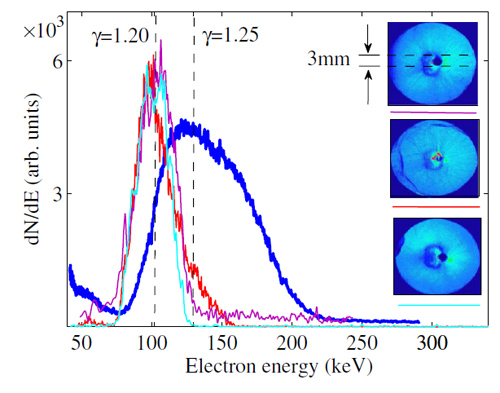Recently, High Field Laser State Key Laboratory at Shanghai Institute of Optics and Fine Mechanics, Chinese Academy of Sciences (SIOM, CAS) have reported a novel scheme to generate stable collimated quasimonoenergetic electron bunches from laser-irradiated on a Al target at moderate intensity ~1017 W/cm2 [Phys. Rev. Lett. 109, 115002 (2012)].
The group utilized high contrast ratio (~108) and moderate intensity (~1017) ultra-short laser system to carry out the experiments. They obtained stable collimated quasimonoenergetic electron bunches in the specular direction but deviated somewhat toward the target normal, and an evacuation structure in the mirror position of the specular direction. The electron bunches characteristic such as energy, divergence, charges and emission direction can be manipulated by controlling laser parameters.
In order to illustrate the formation mechanics of this unique physics phenomenon, the authors proposed a two step model “Electron Emission at Locked Phases from the Laser-Driven Surface Plasma Wave”, which reveal the emission and deflection mechanics of collimated quasimonoenergetic electron bunch: high field ultrafast laser driven the plasma wave along the target surface. Then the incident laser and its coherent reflection set up the interference field. In each cycle of the laser oscillation, some electrons at a favorable phase at the top of their nearescape orbits escape away from the plasma wave more or less along the specular direction. They are acted on by the interference field at the locked phases and inevitably steered slightly to the target normal.
Since the repulsion effect of the ponderomotive force of the interference field always exists, the issue on the phase of electron emission from the laser-solid interaction, should be inspected extensively in a much broader range of laser parameters. In the meantime, the periodic repetition of the electron emission, every optical cycle, leads to a pulse train of collimated e beams with subcycle duration, which may open the door of attosecond ultrafast electron detection in the future.
This work was supported by the National Basic Research Program of China (Contracts No: 2011CB808100, No. 2010CB923203), NNSF of China (Contracts No. 10974214 and No. 60921004), Shanghai Science and Technology Talent Project (12XD1405200), and the State Key Laboratory Program of the Chinese Ministry of Science and Technology.
FIG. 1. Single-shot images of the electron angular distributions. (a-d) Corresponding to different focus positions with Dx =0, 120, 240, 360μm,respectively. Dashed lines show the LSD at 45o and the TND at 90o. (e) A 30-mm circular aperture was placed in front of the IP to calibrate the LSD, The IP was placed at 6 cm away from the focus. (f-h) Corresponding to different laser incident angles of 34o, 60o, 82o, respectively. (image by SIOM)

FIG. 2. Shot-to-shot energy spectra of the collimatede-bunches measured at φ=48o, as well as the peripheral electrons measured at φ=55o (blue line). A 3-mm circular aperture covered with an IP was placed at the entrance of the magnet to pick out the collimated e-bunches as shown in the insets. The laser intensity at the target surface was 1×1017 W/cm2, and the incident angle was 45o.(image by SIOM)

FIG. 3. (a) Spatial distribution of longitudinal electric field amplitudeEz and (b) the electron densityat the peak laser intensity.(c)Momentum distribution of electrons within a spatial period (the yellow rectangle zone in (b)) along the surface.(d) Spatial distributions of the electric field amplitude Ez (red line) and electron density (blue line) at the wave crest (z= 4.9λ) along the surface direction.(image by SIOM)